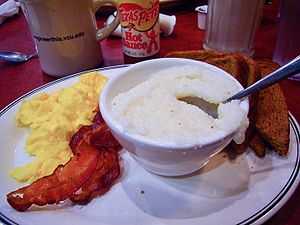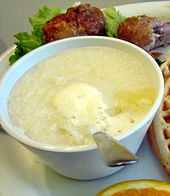Grits
| Grits | |
|---|---|
| mainly a breakfast side-dish | |
 | |
| Place of origin: | |
| Southern United States | |
| Creator(s): | |
| Native Americans | |
| Serving temperature: | |
| warm to hot | |
| Main ingredient(s): | |
| ground corn | |
| Variations: | |
|
Hominy grits Yellow speckled grits | |
| Other information: | |
| Soul food | |
| Recipes at Wikibooks: | |
|
| |
| Media at Wikimedia Commons: | |
|
|
Grits refers to a ground-corn food of Native American origin, that is common in the Southern United States and eaten mainly at breakfast. Modern grits are commonly made of alkali-treated corn known as hominy.
Grits are similar to other thick maize-based porridges from around the world such as polenta. "Instant grits" have been processed to speed cooking.
The word "grits" derives from the Old English word "grytt," meaning coarse meal.[1] This word originally referred to wheat and other porridges now known as groats in parts of the UK. Maize, unknown in Europe in the Middle Ages, is a food derived from corn (a New World plant) and "corn" had been used to describe wheat products in many European regions. "Grits" may be either singular or plural; historically, in the American South the word was invariably singular notwithstanding its plural form (cf. such food names as "spaghetti" or "linguine", likewise plural in form).
Origins
Grits have their origins in Native American corn preparation. Traditionally, the hominy for grits was ground by a stone mill. The results are passed through screens, with the finer sifted materials being grit meal, and the coarser being grits. Many communities in the United States used a gristmill until the mid-twentieth century, with families bringing their own corn to be ground, and the miller retaining a portion of the corn as a fee. In South Carolina, state law requires grits and corn meal to be enriched, similar to the requirements for flour, unless the grits are ground from corn from which the miller keeps part of the product for a fee.[2]
Three-quarters of grits sold in the U.S. are sold in the South, throughout an area stretching from Texas to Virginia, sometimes referred to as the "grits belt".[3] The state of Georgia declared grits its official prepared food in 2002.[4] Similar bills have been introduced in South Carolina, with one declaring:
Whereas, throughout its history, the South has relished its grits, making them a symbol of its diet, its customs, its humor, and its hospitality, and whereas, every community in the State of South Carolina used to be the site of a grits mill and every local economy in the State used to be dependent on its product; and whereas, grits has been a part of the life of every South Carolinian of whatever race, background, gender, and income; and whereas, grits could very well play a vital role in the future of not only this State, but also the world, if as Charleston's The Post and Courier proclaimed in 1952, "An inexpensive, simple, and thoroughly digestible food, [grits] should be made popular throughout the world. Given enough of it, the inhabitants of planet Earth would have nothing to fight about. A man full of [grits] is a man of peace."[5]
In the South Carolina Low Country region the uncooked ground corn is referred to as "grist" and the cooked dish is "hominy." This should not be confused with the more usual usage of hominy.
Grits are usually either yellow or white, depending on the color of corn. The most common version found in supermarkets is "quick" grits in which the germ and hull have been removed. Whole kernel grits sometimes are called "Speckled." Grits are prepared by simply boiling the ground kernels into a porridge until enough water is absorbed or vaporized to leave it semi-solid.
Preparation

Whole kernel grits are prepared by adding five or six parts boiling water (seasoned with salt - 1/4 tsp for each cup of water) to one part grits and cooking for 20 to 30 minutes. Grits expand when cooked and need periodic stirring to prevent sticking and lumps forming. Grits are most typically served seasoned with generous amounts of butter. On occasion they are served with grated cheese, butter, sausage, bacon, or red-eye gravy; it is significant that corn products are typically not served sweet.[citation needed] Grits may also be accompanied by fried catfish, salmon croquettes, and in the Low Country of coastal Alabama, Mississippi, Louisiana, South Carolina, North Carolina, Georgia, and Virginia, by shrimp as a traditional breakfast dish. Charleston-style grits are boiled in milk instead of water, giving them a creamy consistency.
Solidified cooked grits may be sliced and fried directly in vegetable oil, butter, or bacon grease, or they may be breaded in beaten egg and breadcrumbs first.
Other uses
Folk wisdom contends that dry grits, scattered where ants will eat them, can be used to kill them by causing them to 'explode' as the grits expand inside them. However, laboratory tests on fire ants have shown that grits in soybean oil and treated with pesticide may be used against fire ants. It is the pesticide, not the grits that kills the ants.[6]
See also
- Cuisine of the Southern United States
- Cuisine of the United States
- List of porridges
- Mush (cornmeal)
- Hasty pudding
- Three Sisters (agriculture)
References
- ↑ Harper, Douglas, http://www.etymonline.com/index.php?term=grits, retrieved August 27, 2011 Missing or empty
|title=(help) - ↑ South Carolina Code of Laws, Title 39 – Trade and Commerce, Chapter 29, retrieved Dec 14, 2007
- ↑ Charles L., Cutler (2002). Tracks that speak: the legacy of Native American words in North American culture. USA: Houghton Mifflin. p. 28. ISBN 0-618-06510-5., retrieved Oct 25, 2009
- ↑ Georgia Secretary of State, State Prepared Food, retrieved Dec 14, 2007
- ↑ South Carolina General Assembly 113th Session, 1999–2000, Bill Number: 4806, retrieved Dec 14, 2007
- ↑ Drees, Bastiaan. "Laboratory Assay of Effect of Instant Grits and Malt-O-Meal for Imported Fire Ant Control". Retrieved November 12, 2009.
External links
| Look up grits in Wiktionary, the free dictionary. |
| Wikimedia Commons has media related to Grits. |
| Wikibooks Cookbook has a recipe/module on |
- Grist Mills, Grits Festivals, Recipes, and Photos – SCIway.net, South Carolina Information Highway
- Grits Worth Kissin': Southern Favorite Boasts Universal Appeal, Just A Pinch Recipe Club
| |||||||||||||||||||||||||||||||||
